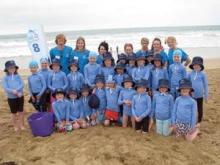ORLANDO – Physicians faced unanticipated challenges when they launched a campaign to increase sun-protective behaviors for a high-risk group along the beaches of Australia.
The initiative targeted training programs for junior lifeguards or "nippers," as they are called in Australia. Nippers have multiple risk factors for melanoma, including skin types I and II, summertime sun exposure, and a younger age. "Children are the most vulnerable," Dr. Anthony Dixon said at the annual meeting of the Florida Society of Dermatologic Surgeons.
"I knew I had to do something. Nippers are seen all over Australia. And they don’t wear a lot – they wear funny hats where the ears stick out," said Dr. Dixon, a dermatologic surgeon in private practice Geelong, Victoria. He felt compelled to act after seeing "more and more" of his patients develop skin cancer.
Dr. Dixon and his associates recommended four major changes to the nipper programs, which train children aged 6-12 years to become lifeguards. The recommended changes were:
P Do not hold nipper training between the hours of 11 a.m. and 4 p.m. "UVB is focused toward the middle of the day. We know that, the public does not," Dr. Dixon said. He estimated that nippers would receive less UV exposure during early-morning training.
P The children should wear rash vests, preferably with long sleeves.
P They should also wear broad-brimmed hats while awaiting training exercises
P Sunscreen should be available and reapplied frequently.
"We would all call that … common sense," said Dr. Dixon. "If only the lifesaving association did what they say in their manual." Their "Public Safety and Aquatic Rescue" manual addresses sun safety on page 15 of its 170 pages. "That is not too bad," he said. It advocates application of sunscreen before sun exposure, for example.
Dr. Dixon and his associates launched the campaign in January 2009 during the peak of summer in the southern hemisphere. Nipper training clubs agreed to the recommendations. However, some programs changed more readily than others, often for unexpected reasons.
For example, the nipper training club at Anglesea Beach did not immediately take to the recommendations, Dr. Dixon said. Program director Peter Foster ("Nipper Pete") briefed the children on the new program while they were standing in full sun. Sunscreen was repeatedly mentioned, but it was not applied until after the briefing. Also, the nippers did not don broad-brimmed hats because they had to wear hats with the sponsor’s name.
Dr. Dixon returned at a later date to observe any progress. "I saw kids at noon wearing only Speedos, [so they had] enormous sun exposure," Dr. Dixon said. "Nipper Pete saw me up on the sand dune with a camera and he panicked." He called the kids over and lectured them.
Sun exposure reduction is not as automatic as other protections, Dr. Dixon said. For example, "if that kid was too far out in the water, Nipper Pete would have gone out, pulled him in, and would have then given him the lecture about going out too deep."
Unbeknownst to Dr. Dixon, initial resistance to moving nipper training at Anglesea Beach to earlier in the morning had to do with a thriving business on the beach. Pressure from a sausage business that was making good money selling lunch to the nippers, their family members, and the trainers impeded the sun safety recommendation. Upon discovering this, Dr. Dixon intervened again. Eventually all parties agreed to conduct training earlier, and for the business to sell donuts instead.
Another nipper training program, in contrast, enacted the recommendations immediately. "The club at Jan Juc Beach decided to change everything with no briefing. They e-mailed the participants beforehand." All the nippers wore bucket hats while waiting for their training exercises, for example.
"So what others said was impossible was being done two beaches down," he said.
Part of the challenge of initiating behavioral changes is a misperception about the relative risk of sun exposure compared with other beach dangers, Dr. Dixon said. When asked about risk factors for death at the beach, "most people would mention drowning first," he said. However, there are 7 deaths from melanoma and 2 deaths from other skin cancers per 100,000 people in Australia each year, compared with 1.2 deaths per 100,000 people for accidental drowning. Put another way, for each person who dies from drowning, 46 Australians die from melanoma.



